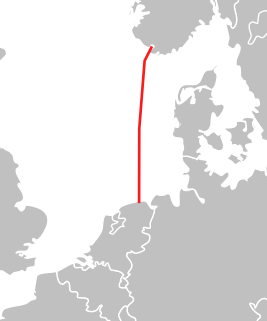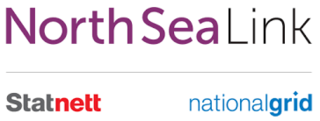Related Research Articles

A high-voltage, direct current (HVDC) electric power transmission system uses direct current (DC) for the transmission of electrical power, in contrast with the more common alternating current (AC) systems.

The HVDC Cross-Channel is the name given to two different high-voltage direct current (HVDC) interconnectors that operate or have operated under the English Channel between the continental European and British electricity grids. The cable is also known as IFA, and should not be confused with IFA-2, another interconnect with France.
The HVDC Inter-Island link is a 610 km (380 mi) long, 1200 MW bipolar high-voltage direct current (HVDC) transmission system connecting the electricity networks of the North Island and South Island of New Zealand together. It is commonly referred to as the Cook Strait cable in the media and in press releases, although the link is much longer than its Cook Strait section, and the submarine section consists of 3 parallel cables. The link is owned and operated by state-owned transmission company Transpower New Zealand.
The National Electricity Market (NEM) is an arrangement in Australia's electricity sector for the connection of the electricity transmission grids of the eastern and southern Australia states and territories to create a cross-state wholesale electricity market. The Australian Energy Market Commission develops and maintains the Australian National Electricity Rules (NER), which have the force of law in the states and territories participating in NEM. The Rules are enforced by the Australian Energy Regulator. The day-to-day management of NEM is performed by the Australian Energy Market Operator.
HVDC Leyte–Luzon is a high-voltage direct current transmission link in the Philippines between geothermal power plants on the islands of Leyte and Luzon.

The HVDC Moyle Interconnector is the 500 MW HVDC link between Auchencrosh, South Ayrshire in Scotland and Ballycronan More, County Antrim in Northern Ireland, which went into service in 2001. It is owned and operated by Mutual Energy.
The Isle of Man to England Interconnector is a submarine power cable connecting the transmission system of the Manx Electricity Authority to that of Great Britain. With an undersea section of approximately 104 km, it is the second longest AC undersea cable in the world. It was laid in 1999 between Bispham, Blackpool, England, and Douglas Head on the Isle of Man, commencing commercial operations in November 2000. It is capable of continuous operation of 40 MW at 90 kV

NorNed is a 580-kilometre (360 mi) long high-voltage direct current submarine power cable between Feda in Norway and the seaport of Eemshaven in the Netherlands, which interconnects both countries' electrical grids. It was once the longest submarine power cable in the world. Budgeted at €550 million, and completed at a cost of €600m, the NorNed cable is a bipolar HVDC link with a voltage of ±450 kV and a capacity of 700 MW. NorNed is a joint project of the Norwegian transmission system operator Statnett and its Dutch counterpart TenneT. The cable system itself and the two converter stations were produced by ABB.
Murraylink is an Australian high voltage direct current electricity transmission link between Berri in South Australia and Red Cliffs in Victoria, connecting the two state electricity grids. Murraylink was commissioned in 2002 and is believed to be the world's longest underground transmission system and cost more than A$177 million. It was built by TransEnergie Australia, a subsidiary of Hydro-Québec. It was sold to the Australian Pipeline Trust in March 2006 for A$153 million. In December 2008 ownership of Murraylink was transferred to the newly formed Energy Infrastructure Investments Group, while APA continued as the operator. The ownership of EII is APA with 19.9%, with the balance with Japan-based Marubeni Corporation with 49.9% and Osaka Gas with 30.2%.

A submarine power cable is a transmission cable for carrying electric power below the surface of the water. These are called "submarine" because they usually carry electric power beneath salt water but it is also possible to use submarine power cables beneath fresh water. Examples of the latter exist that connect the mainland with large islands in the St. Lawrence River.
The East–West Interconnector is a 500 MW high-voltage direct current submarine and subsoil power cable which connects the Irish and British electricity markets. The project was developed by the Irish national grid operator EirGrid.

The Electricity Commission of New South Wales, sometimes called Elcom, was a statutory authority responsible for electricity generation and its bulk transmission throughout New South Wales, Australia. The Commission was established on 22 May 1950 by the Electricity Commission Act 1950 to take control of power generation in the State. The Commission acquired the power stations and main transmission lines of the four major supply authorities: Southern Electricity Supply, Sydney County Council, the Department of Railways and the Electric Light and Power Supply Corporation Ltd, known as the Balmain Electric Light Company, to acquire the Balmain Power Station. The Commission was responsible for the centralised co-ordination of electricity generation and transmission in the State, and some local councils continued to be distributors of electricity only.
TenneT is a transmission system operator in the Netherlands and in a large part of Germany.

BritNed is a 1,000 MW high-voltage direct-current (HVDC) submarine power cable between the Isle of Grain in Kent, the United Kingdom; and Maasvlakte in Rotterdam, the Netherlands.

The North Sea Link is a 1,400 MW high-voltage direct current submarine power cable between Norway and the United Kingdom.
The Western HVDC Link is a high-voltage direct current (HVDC) undersea electrical link in the United Kingdom, between Hunterston in Western Scotland and Flintshire Bridge in North Wales, routed to the west of the Isle of Man. It has a transmission capacity of 2,200 MW and was expected to cost £1bn. The link entered operational service on 7 December 2017 at a reduced capacity of 900 MW pending further work at Hunterston. It entered full use on 16 October 2018.
An HVDC converter converts electric power from high voltage alternating current (AC) to high-voltage direct current (HVDC), or vice versa. HVDC is used as an alternative to AC for transmitting electrical energy over long distances or between AC power systems of different frequencies. HVDC converters capable of converting up to two gigawatts (GW) and with voltage ratings of up to 900 kilovolts (kV) have been built, and even higher ratings are technically feasible. A complete converter station may contain several such converters in series and/or parallel to achieve total system DC voltage ratings of up to 1,100 kV.

APA Group is a company in Australia which owns and operates natural gas and electricity assets. It is Australia's largest natural gas infrastructure business. It is listed on the Australian Stock Exchange.
Gridlink Interconnector is a proposed submarine power cable between England and France. The 1,400 MW HVDC connector would link Kingsnorth National Grid substation in north Kent, England, with RTE Warande substation in Bourbourg (Nord) near Dunkirk in northern France.
References
- 1 2 "Development of Electricity Supply to the NSW Far North Coast. Supplementary Report" (PDF). TransGrid. May 2010. p. 7. Archived from the original (PDF) on 24 July 2011. Retrieved 12 June 2011.
- 1 2 3 "Directlink Project Queensland – New South Wales in Australia" (PDF). ABB. Archived from the original (PDF) on 20 August 2011. Retrieved 9 June 2011.
- 1 2 Grant-Taylor, Tony (20 December 2016). "APT buys DirectLink line". The Courier-Mail . News Limited . Retrieved 12 June 2011.
- ↑ "Network Interconnection: Murraylink: the underground connection". Power-Gen Worldwide. PennWell Corporation. 1 May 2001. Retrieved 8 June 2011.
- 1 2 Sood, Vijay K. (2004). HVDC and FACTS controllers: applications of static converters in power systems. Springer. pp. 172, 174. ISBN 978-1-4020-7890-3.
- ↑ "Electric/Gas Utilities Could Threaten Telecoms". Transmission & Distribution World. Penton Media. 1 February 1999. Archived from the original on 28 September 2011. Retrieved 12 June 2011.
- ↑ Wong, Fayen (25 February 2008). "APA Group H1 profit rises, upgrades outlook". Reuters . Retrieved 12 June 2011.
- ↑ "AER final decision approves Directlink conversion" (Press release). AER. 10 March 2006. Archived from the original on 25 March 2012. Retrieved 12 June 2011.
- ↑ "Electricity Transmission Network Service Providers Directlink & Murraylink Amended Cost Allocation Methodologies" (PDF). AER. March 2010. Retrieved 12 June 2011.
- ↑ Electricity Transmission Network Service Providers - Directlink and Murraylink amended Cost Allocation Methodologies - March 2010
- ↑ "electricity transmission interconnectors - APA Group". www.apa.com.au. Retrieved 30 December 2018.
- 1 2 "Terranora interconnector (Directlink)". ABB . Retrieved 9 June 2011.
- ↑ Arrillaga, J.; Liu, Y. H.; Watson, N. R. (2007). Flexible power transmission: the HVDC options. John Wiley & Sons. p. 310. ISBN 978-0-470-05688-2.
- ↑ "Review of Last Resort Planning Powers" (PDF). Sinclair Knight Merz . AEMC. 17 September 2010. p. 5. Archived from the original (PDF) on 6 March 2016. Retrieved 12 June 2011.